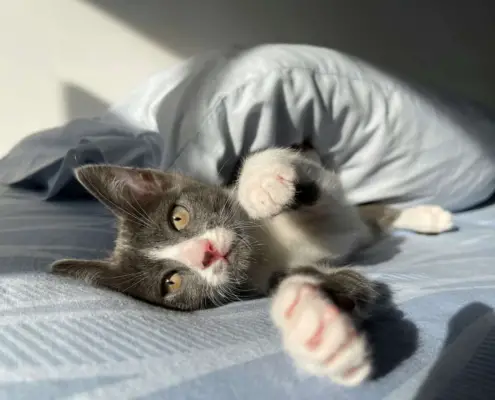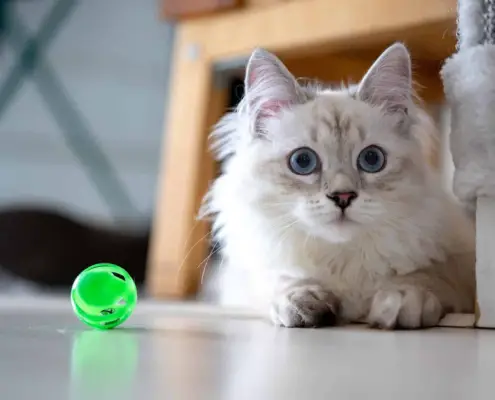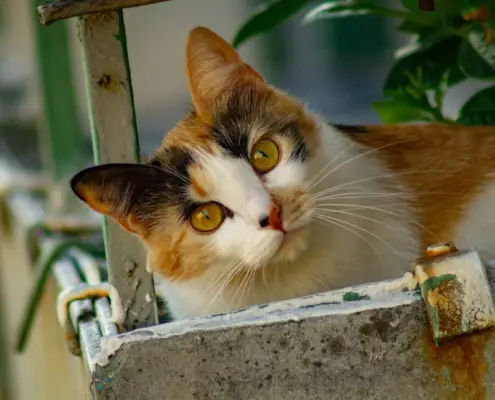
Feline vision is a marvel of nature, captivating cat lovers and scientists alike. The eyes of these graceful creatures are not only beautiful, but also highly efficient tools that enable cats to navigate their surroundings with precision and grace. In this article, we will delve into the captivating world of feline vision, exploring just how large cat eyes really are and the intricate anatomy that makes them so unique.
Anatomy of cat eyes
To truly understand the size and capabilities of cat eyes, it is essential to delve into their anatomy. Cats have what is known as “binocular vision,” which means that their eyes are positioned in the front of their face, allowing them to focus on a single point with both eyes simultaneously. This provides them with exceptional depth perception, essential for their hunting prowess.
One of the most striking features of cat eyes is their size. Compared to the average human eye, cat eyes are significantly larger. Their pupils can dilate to an astounding extent, allowing them to gather as much light as possible, especially in low-light conditions. This ability is due to a structure known as the tapetum lucidum, which reflects light back through the retina, enhancing the cat’s night vision.
Understanding cat vision
Cat vision differs from human vision in several key ways. Firstly, cats have a higher number of rod cells in their retinas, which are responsible for detecting light and motion. This abundance of rod cells gives cats heightened sensitivity to movement, allowing them to spot even the slightest twitch of a mouse tail. Additionally, cats have a reduced number of cone cells, which are responsible for color vision. As a result, cats see the world in a more muted color palette compared to humans.
Another fascinating aspect of cat vision is their ability to see in ultraviolet (UV) light. While humans are unable to perceive UV light, cats have a specialized structure in their eyes that enables them to do so. This ability aids them in hunting, as certain prey species leave UV marks that are invisible to human eyes but stand out to cats.
The size of cat eyes compared to other animals
When it comes to eye size relative to body size, cats are among the champions of the animal kingdom. The average domestic cat has eyes that are proportionally larger than those of many other mammals, including dogs and humans. This is particularly true for big cats such as lions and tigers, whose eyes are even more impressive in size.
The size of cat eyes is a reflection of their evolutionary adaptations. Cats are predators that rely on their vision to hunt and survive in a variety of environments. Their large eyes allow them to gather more light, giving them a distinct advantage in low-light conditions. Additionally, the size of their eyes helps them to detect motion more easily, ensuring that they don’t miss a potential prey or predator in their surroundings.
Factors that contribute to the large size of cat eyes
The large size of cat eyes is not solely due to the need for enhanced vision. There are several factors that contribute to their impressive proportions. One such factor is the positioning of the eyes on the cat’s head. Unlike humans, who have eyes that are parallel to each other, cat eyes are slightly angled forward. This positioning provides cats with a wider field of view, allowing them to have a better peripheral vision and spot potential threats or prey from various angles.
Another factor that contributes to the large size of cat eyes is the presence of a reflective layer behind the retina called the tapetum lucidum. This layer acts like a mirror, reflecting light back through the retina and increasing the sensitivity of the cat’s vision. The tapetum lucidum also gives cats their characteristic glowing eyes in the dark, as light is reflected outwards.
How cat vision differs from human vision
While cats and humans share many similarities in the basic structure of their eyes, there are significant differences in how they perceive the world. One of the most notable distinctions is the ability of cats to see in low-light conditions. Cats have a higher number of rod cells in their retinas, which are more sensitive to light than the cone cells responsible for color vision. This abundance of rod cells allows cats to see clearly in dim lighting, giving them a distinct advantage when hunting at night.
Another difference in cat and human vision is the range of motion that cats can detect. Cats have a wider field of view than humans, with their eyes positioned at a slight angle. This gives them a panoramic view of their surroundings, allowing them to spot potential threats or prey from various angles. Additionally, cats have exceptional peripheral vision, enabling them to detect even the slightest movement at the edges of their visual field.
The advantages of large cat eyes
The large size of cat eyes comes with numerous advantages that contribute to their survival and hunting abilities. One of the most significant advantages is their exceptional night vision. Cats have a specialized structure called the tapetum lucidum, which reflects light back through the retina, effectively doubling the amount of light available for vision. This adaptation allows cats to see clearly even in near-total darkness, giving them a distinct advantage when hunting nocturnal prey.
Furthermore, the large size of cat eyes helps with their depth perception. Cats have excellent stereoscopic vision, which allows them to accurately judge distances. This skill is crucial for their hunting prowess, as it enables them to pounce on prey with precision and accuracy. The combination of large eyes and binocular vision ensures that cats can accurately track and capture their targets, even in challenging environments.
Challenges of having large cat eyes
While large cat eyes provide numerous advantages, they also come with their share of challenges. The first challenge is related to the size and shape of the cat’s head. Cats have a relatively small and compact skull, which limits the amount of space available for their eyes. As a result, their eyes are positioned close together, which can affect their depth perception at close distances.
Another challenge is the vulnerability of large cat eyes to injuries. Due to their prominent position, cat eyes are more exposed and prone to damage. Scratches, foreign objects, and infections can all pose a risk to the health and functionality of a cat’s eyes. As responsible cat owners, it is crucial to provide a safe environment for our feline companions, minimizing potential hazards that could harm their precious eyesight.
Interesting facts about cat eyes
Cat eyes hold many intriguing secrets and fascinating facts. Did you know that cats have a reflective layer called the tapetum lucidum, which is responsible for their characteristic glowing eyes in the dark? This layer reflects light back through the retina, enhancing their night vision. Additionally, cats possess a third eyelid called the “haw,” which acts as a protective layer, keeping their eyes moist and free from debris.
Another interesting fact is that cats have a wider field of view compared to humans. While humans have an approximate field of view of 180 degrees, cats can see up to 200 degrees, thanks to the slight angle at which their eyes are positioned. This wider field of view allows cats to detect movement and potential threats from various angles, making them highly vigilant and alert creatures.
Appreciating the wonder of feline vision
In conclusion, the world of feline vision is a captivating realm that continues to amaze and intrigue us. The large size of cat eyes, combined with their unique anatomy and visual capabilities, make them extraordinary creatures to study and appreciate. From their excellent night vision to their exceptional depth perception, cat eyes are a testament to the wonders of evolution and adaptation. As cat lovers, let us continue to marvel at the beauty and marvel of feline vision, cherishing the unique gifts that our furry friends possess.
If you enjoyed my article, I would appreciate you sharing it with your network.

Sima Ndlebe
Sima writes for CatBuzz. He is interested in Cats, Health and Fitness, and Entrepreneurship.
Published: 30 October 2023



